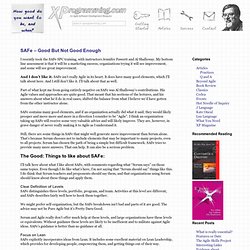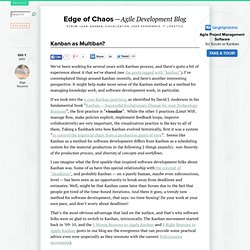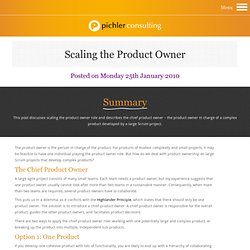

Large Scale Scrum - More with LeSS. Background In 2003, when Craig published Agile & Iterative Development [1], many “knew” that agile development was for small groups.

However, we became interested in – and got increasing requests – to apply Scrum to very large, multisite, and offshore product development. So, since 2005 we have worked with clients to scale up – often for “embedded” systems. Today, the two Large-Scale Scrum (LeSS) frameworks described herein have been introduced to big groups worldwide in disparate domains, including telecom-infrastructure-equipment providers such as Ericsson [2], investment-banking clients such as Bank of America-Merrill Lynch and JPMorgan, plus many more. To quantify “large”, we’ve seen our LeSS framework–2 applied in groups of up to 1500 people, involving 7 developments sites spanning the globe. Facing Criticism: Is SAFe the "Fast Food" of Agile? Agile Can’t Scale: Fact or Myth? If you define ”Agile” as a team-level methodology, then I’ll be a little provocative here and suggest that Team Agile is not scalable.

That’s my observation having worked with Agile PMO and Portfolio Management for the better part of the last eight years with a number of companies. I’ve watched more than one company crash and burn attempting to scale using Team Agile. On the other hand, if you are defining ”Agile” as an organizational-level methodology, then I not only suggest that Business Agile is scalable, I absolutely know for a fact that it is possible … since we’ve done it, hands-on, for a number of companies. In the same way that a start-up’s growth curve outstrips a founders ability to lead a maturing organization, is there a point in time that the explosive growth of an Agile implementation outpaces the ability of the organization to continue on a productive path?
In the case of Team Agile the answer is yes. Success with SAFe and Other Frameworks for Scaling Agile: A Case Study. The following is a guest post from Brad Swanson, VP and Sr.

Agile Coach at agile42 Scaling agile is one of today’s top challenges for many. I hear it from our customers all of the time. When agile and non-agile worlds collide within an organization, time to market and software quality often suffer. There are a number of fans in favor of the Scaled Agile Framework® (SAFe™) as the solution. To demonstrate my point, I’d like to share this case study… We recently worked with a leading cable TV company that faced long and challenging development cycles with software quality problems. 12+ month release cycle; unable to respond to a rapidly changing marketplaceMissed delivery dates; schedule slippageQuality problems due to late integration and 3 concurrent versions in development Agile methods and SAFe reduced time-to-market for major releases from 12+ to only 4 months, the shortest practical timeframe, given the cost of deploying firmware to over 11 million DVRs nationwide.
PortfolioProgramTeam. SAFe – Good But Not Good Enough. I recently took the SAFe SPC training, with instructors Jennifer Fawcett and Al Shalloway.

My bottom line assessment is that it will be a marketing success, organizations trying it will see improvement, and some will see great improvement. And I don’t like it. SAFe isn’t really Agile in its heart. It does have many good elements, which I’ll talk about here. And I still don’t like it. Part of what kept me from going entirely negative on SAFe was Al Shalloway’s contributions. Kanban as Multiban? We’ve been working for several years with Kanban process, and there’s quite a bit of experience about it that we’ve shared (see the posts tagged with “kanban”).

I’ve contemplated things around Kanban recently, and here’s another interesting perspective. It might help make more sense of the Kanban method as a method for managing knowledge work, and software development work, in particular. I can imagine what the first sparkle that inspired software development folks about Kanban was. Some of us have this special relationship with the concept of “deadlines”, and probably Kanban — on a purely human, maybe even subconscious, level — has been seen as an opportunity to break away from deadlines and estimates. Well, might be that Kanban came later than Scrum due to the fact that people got tired of the time-boxed iterations.
That’s the most obvious advantage that laid on the surface, and that’s why software folks were so glad to switch to Kanban, intrinsically. Scaled Agile Framework: The Gods Have Spoken « i.am.agile. September 24, 2012 Today marks an important milestone in our Agile transformation here at Valpak.

We put in place the final major piece of Dean Leffingwell’s Scaled Agile Framework , the Architecture Kanban, or what I like to refer to as our Mount Olympus. Agile Success Factors. Agile 101: Larger Teams. Enterprise Scale Agility. How to Scale the Scrum Product Owner. The product owner is the person in charge of the product.

For products of modest complexity and small projects, it may be feasible to have one individual playing the product owner role. But how do we deal with product ownership on large Scrum projects that develop complex products? The Chief Product Owner A large agile project consists of many small teams. Each team needs a product owner, but my experience suggests that one product owner usually cannot look after more than two teams in a sustainable manner. This puts us in a dilemma, as it conflicts with the Highlander Principle, which states that there should only be one product owner.
There are two ways to apply the chief product owner role: working with one potentially large and complex product, or breaking up the product into multiple, independent sub products. Option 1: One Product Option 2: Product Suite Summary If you work with more than one product owner, put one individual in charge of the overall product.